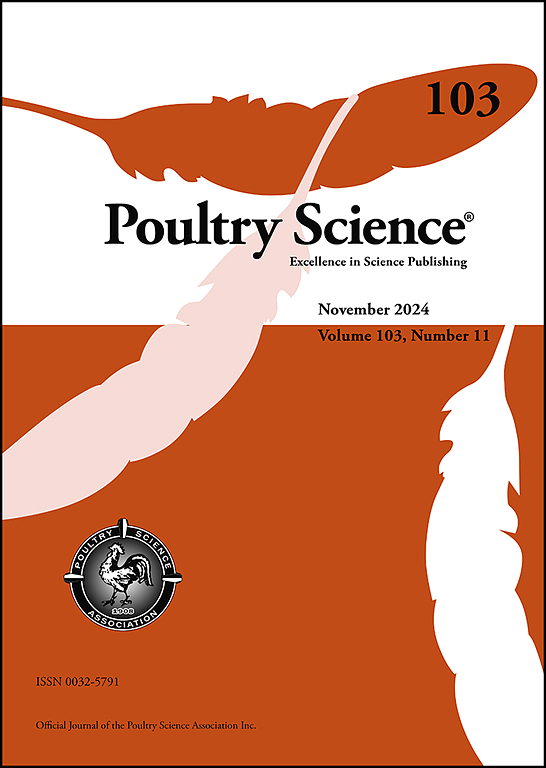植物性饲料添加剂预防蛋鸡脂肪肝出血性综合征的研究
IF 4.2
1区 农林科学
Q1 AGRICULTURE, DAIRY & ANIMAL SCIENCE
引用次数: 0
摘要
脂肪肝出血性综合征(FLHS)是蛋鸡生产中的主要问题,造成重大的经济损失和动物福利问题。本试验旨在比较评价三种功能性饲料添加剂——多混料(MM)、柑橘果胶(CP)和植物性添加剂(PA)在标准日粮(SD)和高能量低蛋白激发日粮(CD)诱导FLHS母鸡中的预防效果。试验采用4 × 2因子设计,随机选取65 ~ 77周龄的罗曼LSL-Lite蛋鸡384只。与SD相比,饲喂CD显著降低采食量(FI)、产蛋量(EP)、蛋重(EW)和蛋质量(EM);0.05)。各时期各生产性状均观察到显著的饲粮与添加剂相互作用(P = 0.0001)。添加MM可显著恢复CD饲养母鸡的FI,显著提高EP和EM,同时在CD处理中产生最高的EW (P <;0.05)。CP提高了CD组饲料系数(FCR) (P = 0.0191),降低了EW (P = 0.0237)。添加剂对饲喂SD的母鸡影响最小。对于血液学参数,检测到显著的饲粮与添加剂的相互作用。MM显著降低cd饲养母鸡的天冬氨酸转氨酶(AST)活性(P = 0.0001)、尿酸(P = 0.0049)和甘油三酯(TG) (P = 0.0001),提高总蛋白(P = 0.0001)和高密度脂蛋白-胆固醇(HDL-c) (P = 0.0075)。SD + CP组和SD + MM组低密度脂蛋白-胆固醇(LDL-c)显著降低(P = 0.0001)。cd饲母鸡肝脏病变评分显著高于cd饲母鸡(P = 0.001);然而,补充MM可显著减轻该组的肝损伤。综上所述,在饲料挑战下,MM对FLHS具有最一致的保护作用,可改善生产性能、血液参数和肝脏健康。本文章由计算机程序翻译,如有差异,请以英文原文为准。
Phytogenic feed additives as an approach to prevent fatty liver hemorrhagic syndrome in laying hens
Fatty liver hemorrhagic syndrome (FLHS) is a major concern in laying hen production, causing significant economic losses and animal welfare issues. This study aimed to comparatively evaluate the preventive effects of three functional feed additives—a multi-mix (MM), citrus pectin (CP), and phytogenic additives (PA)—in hens fed either a standard diet (SD) or a high-energy, low-protein challenge diet (CD) formulated to induce FLHS. A total of 384 Lohmann LSL-Lite hens (65 to 77 weeks of age) were randomly assigned in a 4 × 2 factorial design. Feeding the CD significantly reduced feed intake (FI), egg production (EP), egg weight (EW), and egg mass (EM) compared to the SD (P < 0.05). Significant diet × additive interactions were observed for all performance traits across all periods (P = 0.0001). MM supplementation notably restored FI and significantly improved EP and EM in CD-fed hens, while also yielding the highest EW among CD treatments (P < 0.05). CP improved feed conversion ratio (FCR) in the CD group (P = 0.0191), but reduced EW (P = 0.0237). Additives had minimal effect in hens fed the SD. For hematological parameters, significant diet × additive interactions were detected. MM significantly decreased aspartate aminotransferase (AST) activity (P = 0.0001), uric acid (UA) (P = 0.0049), and triglycerides (TG) (P = 0.0001), whereas it increased total protein (TP) (P = 0.0001) and high-density lipoprotein-cholesterol (HDL-c) (P = 0.0075) in CD-fed hens. Low-density lipoprotein-cholesterol (LDL-c) was significantly reduced in SD + CP and SD + MM groups (P = 0.0001). Hepatic lesion scores were markedly higher in CD-fed hens (P = 0.001); however, MM supplementation significantly reduced liver damage in this group. In conclusion, MM showed the most consistent protective effect against FLHS, improving performance, blood parameters, and liver health under dietary challenge.
求助全文
通过发布文献求助,成功后即可免费获取论文全文。
去求助
来源期刊

Poultry Science
农林科学-奶制品与动物科学
CiteScore
7.60
自引率
15.90%
发文量
0
审稿时长
94 days
期刊介绍:
First self-published in 1921, Poultry Science is an internationally renowned monthly journal, known as the authoritative source for a broad range of poultry information and high-caliber research. The journal plays a pivotal role in the dissemination of preeminent poultry-related knowledge across all disciplines. As of January 2020, Poultry Science will become an Open Access journal with no subscription charges, meaning authors who publish here can make their research immediately, permanently, and freely accessible worldwide while retaining copyright to their work. Papers submitted for publication after October 1, 2019 will be published as Open Access papers.
An international journal, Poultry Science publishes original papers, research notes, symposium papers, and reviews of basic science as applied to poultry. This authoritative source of poultry information is consistently ranked by ISI Impact Factor as one of the top 10 agriculture, dairy and animal science journals to deliver high-caliber research. Currently it is the highest-ranked (by Impact Factor and Eigenfactor) journal dedicated to publishing poultry research. Subject areas include breeding, genetics, education, production, management, environment, health, behavior, welfare, immunology, molecular biology, metabolism, nutrition, physiology, reproduction, processing, and products.
 求助内容:
求助内容: 应助结果提醒方式:
应助结果提醒方式:


